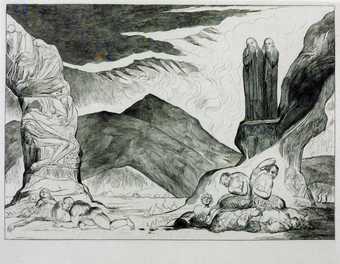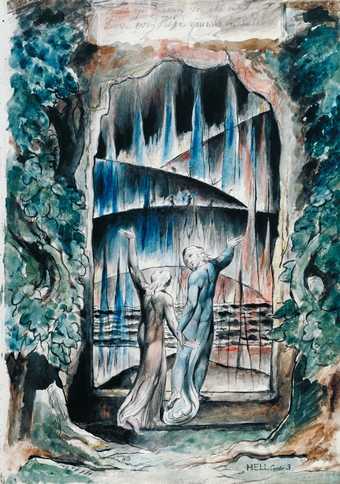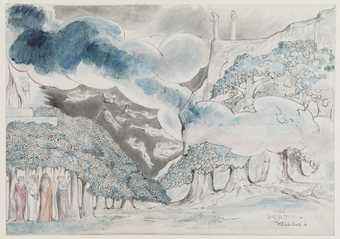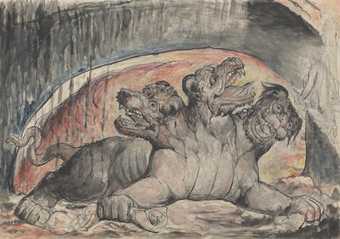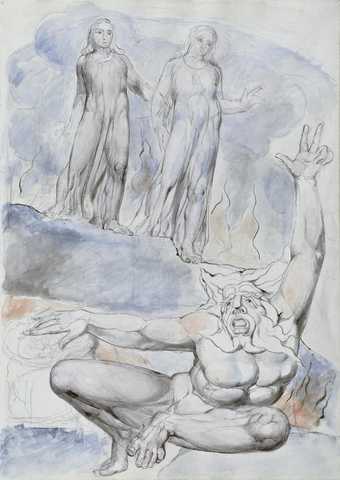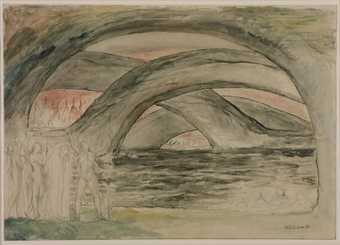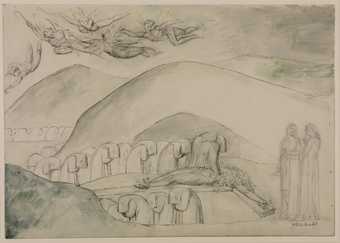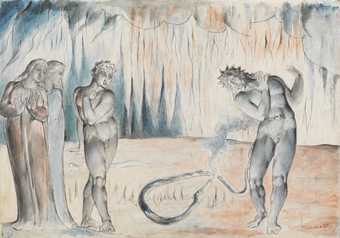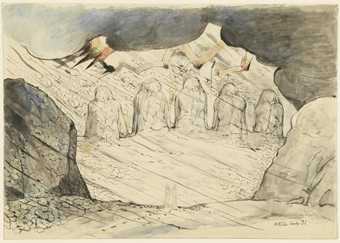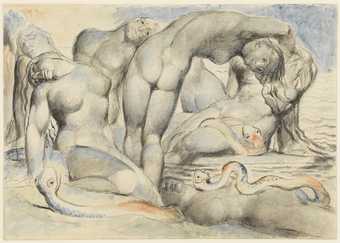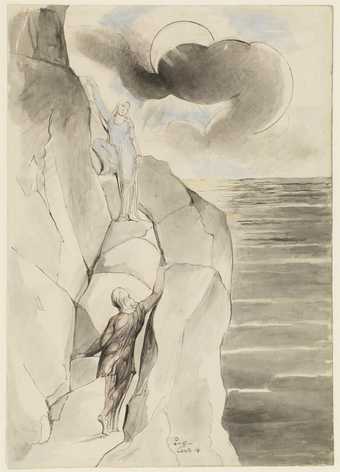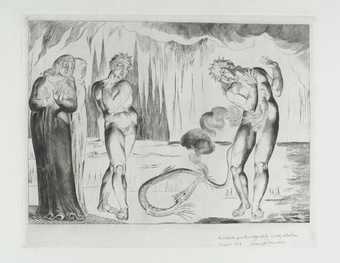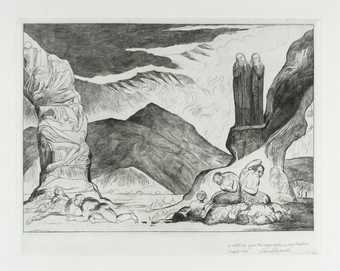
In Tate Britain
Prints and Drawings Room
View by appointment- Artist
- William Blake 1757–1827
- Medium
- Ink and watercolour on paper
- Dimensions
- Support: 372 × 527 mm
- Collection
- Tate
- Acquisition
- Purchased with the assistance of a special grant from the National Gallery and donations from the Art Fund, Lord Duveen and others, and presented through the Art Fund 1919
- Reference
- N03362
Display caption
Gallery label, August 2004
Does this text contain inaccurate information or language that you feel we should improve or change? We would like to hear from you.
Catalogue entry
N03362 The Pit of Disease: the Falsifiers 1824–7 [A00005-A00011; N03351-N03370; T01950-T01956; complete]
N 03362 / B 812 58
Pen and watercolour 372×527 (14 5/8×20 3/4)
Signed ‘WB’ and inscribed ‘HELL Canto 29 & 30’ in ink b.r. and, on reverse in pencil, ‘For this see P 62’ t.c. and ‘28’ t.r., both turned through a right-angle
Watermarked ‘WE’
Purchased with the assistance of a special grant from the National Gallery and donations from the National Art-Collections Fund, Lord Duveen and others, and presented through the National Art-Collections Fund 1919
PROVENANCE As for N03351
EXHIBITED RA 1893 (16); Paris and Vienna 1937 (23)
LITERATURE Rossetti 1863, p.220 no.101e2, and 1880, p.231 no.123e2; Roe 1953, pp.115–17 no.58, repr.; Klonsky 1980, p.150, colour pl.61; Butlin 1981, p.574 no.812 58; Gizzi 1983, p.139 repr.
This is an illustration to Inferno XXIX, 46–84, and XXX, 49–99, a scene in the tenth trench of the eighth circle, that devoted to the falsifiers who are punished with innumerable diseases. The two figures scratching themselves are Griffolino of Arezzo and Capocchio of Florence. The three figures on the left may be Adam of Brescia, described by Dante as being lute-shaped (see especially the engraving), with Potiphar's wife and Sinon the Greek, who persuaded the Trojans to admit the Trojan Horse.
This is one of the subjects engraved by Blake (repr. Roe 1953, pl.58 E, Bindman 1978, pl.652 and Klonsky 1980, pl.108); see also A00010.
The bridge of petrified figures is similar to those that appear in ‘The Devils under the Bridge’ and ‘Dante Striking against Bocca degli Abati’ (National Gallery of Victoria and City Museum and Art Gallery, Birmingham respectively; Butlin 1981, nos.812 34 and 65, repr. Roe 1953, pls.34 and 64, Klonsky 1980, pls.39 and 68 and Gizzi 1983, pp.117 and 146). They seem to represent Fallen Man at his furthest remove from Divine Energy and are a suitable setting for these scenes of physical suffering.
Published in:
Martin Butlin, William Blake 1757-1827, Tate Gallery Collections, V, London 1990
Explore
- literature and fiction(3,138)
-
- characters(438)
- literature (not Shakespeare)(2,276)
- actions: processes and functions(2,161)
-
- looking / watching(581)
- scratching(5)
- man(10,453)
- illness(185)
- mythical, religious, fictional(260)
-
- Hell(93)
- Judaeo-Christian imagery(856)
-
- Hell(252)
- crime and punishment(436)
-
- punishment(22)
You might like
-
William Blake The Pit of Disease: The Falsifiers
1826–7, reprinted 1892 -
William Blake The Inscription over the Gate
1824–7 -
William Blake Homer and the Ancient Poets
1824–7 -
William Blake Cerberus
1824–7 -
William Blake Plutus
1824–7 -
William Blake The Simoniac Pope
1824–7 -
William Blake The Devils, with Dante and Virgil by the Side of the Pool
1824–7 -
William Blake The Hypocrites with Caiaphas. Verso: Sketch of a Stooping Figure
1824–7 -
William Blake The Laborious Passage along the Rocks
1824–7 -
William Blake The Primaeval Giants Sunk in the Soil
1824–7 -
William Blake The Punishment of the Thieves
1824–7 -
William Blake The Ascent of the Mountain of Purgatory
1824–7 -
William Blake The Serpent Attacking Buoso Donati
1826–7, reprinted 1968 -
William Blake The Pit of Disease: The Falsifiers
1826–7, reprinted 1968

